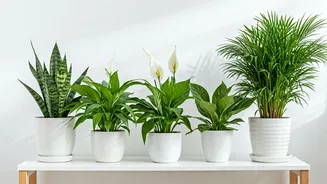The Air Quality Crisis
Delhi's air pollution has reached a critical stage, with the AQI hitting 400, a level classified as hazardous. This poses significant health risks for
inhabitants, including respiratory issues and long-term health complications. The primary contributors to this poor air quality include vehicle emissions, industrial pollutants, construction dust, and seasonal factors like stubble burning. Such extreme levels of pollution necessitate immediate and effective mitigation strategies. Addressing this challenge requires an integrated approach that combines government initiatives, public awareness, and individual actions to safeguard the health of Delhi's population. Improving air quality is essential not only for public health but also for overall environmental sustainability in the region. The impact of such poor air quality disproportionately affects vulnerable populations, making solutions even more urgent.
Snake Plant's Prowess
The Snake Plant, known for its striking, upright leaves, is a standout in air purification. This plant is renowned for its ability to convert carbon dioxide into oxygen at night, making it ideal for bedrooms. It effectively filters common indoor pollutants like formaldehyde, xylene, toluene, and benzene, which are often found in household cleaning products and furniture. Easy to maintain, the Snake Plant thrives on minimal care; it requires infrequent watering and can tolerate low light conditions, making it perfect for both novice and experienced plant owners. Moreover, the snake plant adds an aesthetic element to the living space, contributing to an overall sense of well-being through its striking foliage. Its remarkable ability to purify the air makes it an essential addition to any home battling poor air quality, promoting a healthier indoor environment.
Areca Palm's Benefits
The Areca Palm, also known as the butterfly palm, is an excellent humidifier and air purifier. This plant releases significant amounts of moisture into the air, helping to counteract the dry conditions often associated with air conditioning and heating, which exacerbate respiratory problems. It efficiently removes pollutants such as formaldehyde, xylene, and toluene, commonly found in paints, varnishes, and cleaning agents. Additionally, the Areca Palm is relatively easy to care for, requiring regular watering and bright, indirect light to flourish. Its elegant appearance adds a touch of tropical beauty to any room while simultaneously contributing to improved air quality and increased humidity. This makes it an ideal choice for creating a healthier and more comfortable living environment, particularly beneficial during times of heightened pollution.
Peace Lily's Contribution
The Peace Lily is celebrated not only for its elegant white flowers but also for its effective air-purifying capabilities. This plant is exceptional at removing mold spores and various volatile organic compounds (VOCs) that can be harmful. The Peace Lily excels at removing pollutants like benzene, formaldehyde, and trichloroethylene, commonly found in household chemicals. Beyond its air-purifying properties, it also adds a serene aesthetic to indoor spaces, enhancing the overall ambiance of the room. It thrives in low-light environments and requires moderate watering, making it accessible for indoor cultivation. Adding a Peace Lily to your home will contribute to cleaner air and create a more tranquil living space, making it a great addition to combat indoor air pollution and boost wellness.
Spider Plant's Efficiency
The Spider Plant, a favorite among indoor gardeners, is highly efficient at cleaning the air. It rapidly removes harmful pollutants, including formaldehyde and xylene, from the air. These pollutants are found in common household items, such as adhesives, insulation, and pressed wood products. Known for its ease of propagation, the Spider Plant produces 'spiderettes' or baby plants, making it simple to expand your collection and share them with others. Requiring moderate care and adaptable to a variety of conditions, it provides an accessible and effective way to improve indoor air quality. Its unique appearance and rapid growth make it an attractive and beneficial addition to any home, contributing to a healthier living environment, which makes it perfect for combatting indoor air pollution.















